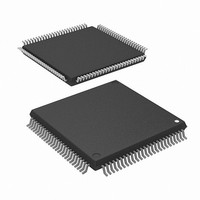R5F2L3AAANFP#U1 Renesas Electronics America, R5F2L3AAANFP#U1 Datasheet - Page 611

R5F2L3AAANFP#U1
Manufacturer Part Number
R5F2L3AAANFP#U1
Description
MCU FLASH 96+4KB 100LQFP
Manufacturer
Renesas Electronics America
Series
R8C/Lx/3AAr
Datasheet
1.R5F2L387ANFPU1.pdf
(864 pages)
Specifications of R5F2L3AAANFP#U1
Core Processor
R8C
Core Size
16/32-Bit
Speed
20MHz
Connectivity
I²C, LIN, SIO, SSU, UART/USART
Peripherals
LCD, POR, PWM, Voltage Detect, WDT
Number Of I /o
88
Program Memory Size
96KB (96K x 8)
Program Memory Type
FLASH
Ram Size
10K x 8
Voltage - Supply (vcc/vdd)
1.8 V ~ 5.5 V
Data Converters
A/D 20x10b; D/A 2x8b
Oscillator Type
Internal
Operating Temperature
-20°C ~ 85°C
Package / Case
100-LQFP
Lead Free Status / RoHS Status
Lead free / RoHS Compliant
Eeprom Size
-
Available stocks
Company
Part Number
Manufacturer
Quantity
Price
- Current page: 611 of 864
- Download datasheet (16Mb)
R8C/L35A Group, R8C/L36A Group, R8C/L38A Group, R8C/L3AA Group,
R8C/L35B Group, R8C/L36B Group, R8C/L38B Group, R8C/L3AB Group
REJ09B0441-0100 Rev.1.00
Page 574 of 802
26.5.3
Figure 26.12 shows an Example of Synchronous Serial Communication Unit Operation during Data Reception
(4-Wire Bus Communication Mode, 8-Bit SSU Data Transfer Length). During data reception, the synchronous
serial communication unit operates as described below (the data transfer length can be set from 8 to 16 bits
using the SSBR register).
When the MCU is set as the master device, it outputs a synchronous clock and inputs data. When the MCU is
set as a slave device, it outputs data synchronized with the input clock while the SCS pin is low-input state.
When the MCU is set as the master device, it outputs a receive clock and starts receiving by performing a
dummy read from the SSRDR register.
After 8 bits of data are received, the RDRF bit in the SSSR register is set to 1 (data in the SSRDR register) and
receive data is stored in the SSRDR register. When the RIE bit in the SSER register is set to 1 (RXI and OEI
interrupt requests enabled) at this time, an RXI interrupt request is generated. When the SSRDR register is read,
the RDRF bit is automatically set to 0 (no data in the SSRDR register).
Read the receive data after setting the RSSTP bit in the SSCRH register to 1 (receive operation is completed
after receiving 1-byte data). The synchronous serial communication unit outputs a clock for receiving 8 bits of
data and stops. After that, set the RE bit in the SSER register to 0 (reception disabled) and the RSSTP bit to 0
(receive operation is continued after receiving 1-byte data) and read the receive data. When the SSRDR register
is read while the RE bit is set to 1 (reception enabled), a receive clock is output again.
When the 8th clock rises while the RDRF bit is set to 1, the ORER bit in the SSSR register is set to 1 (overrun
error: OEI) and the operation is stopped. When the ORER bit is set to 1, reception cannot be performed.
Confirm that the ORER bit is set to 0 before restarting reception.
The timing at which bits RDRF and ORER are set to 1 varies depending on the setting of the CPHS bit in the
SSMR register. Figure 26.12 shows when bits RDRF and ORER are set to 1.
When the CPHS bit is set to 1 (data download at odd edges), bits RDRF and ORER are set to 1 at some point
during the frame.
The sample flowchart is the same as that for the clock synchronous communication mode (refer to Figure 26.8
Sample Flowchart of Data Reception (MSS = 1) (Clock Synchronous Communication Mode)).
Data Reception
Oct 30, 2009
26. Synchronous Serial Communication Unit (SSU)
Related parts for R5F2L3AAANFP#U1
Image
Part Number
Description
Manufacturer
Datasheet
Request
R

Part Number:
Description:
KIT STARTER FOR M16C/29
Manufacturer:
Renesas Electronics America
Datasheet:

Part Number:
Description:
KIT STARTER FOR R8C/2D
Manufacturer:
Renesas Electronics America
Datasheet:

Part Number:
Description:
R0K33062P STARTER KIT
Manufacturer:
Renesas Electronics America
Datasheet:

Part Number:
Description:
KIT STARTER FOR R8C/23 E8A
Manufacturer:
Renesas Electronics America
Datasheet:

Part Number:
Description:
KIT STARTER FOR R8C/25
Manufacturer:
Renesas Electronics America
Datasheet:

Part Number:
Description:
KIT STARTER H8S2456 SHARPE DSPLY
Manufacturer:
Renesas Electronics America
Datasheet:

Part Number:
Description:
KIT STARTER FOR R8C38C
Manufacturer:
Renesas Electronics America
Datasheet:

Part Number:
Description:
KIT STARTER FOR R8C35C
Manufacturer:
Renesas Electronics America
Datasheet:

Part Number:
Description:
KIT STARTER FOR R8CL3AC+LCD APPS
Manufacturer:
Renesas Electronics America
Datasheet:

Part Number:
Description:
KIT STARTER FOR RX610
Manufacturer:
Renesas Electronics America
Datasheet:

Part Number:
Description:
KIT STARTER FOR R32C/118
Manufacturer:
Renesas Electronics America
Datasheet:

Part Number:
Description:
KIT DEV RSK-R8C/26-29
Manufacturer:
Renesas Electronics America
Datasheet:

Part Number:
Description:
KIT STARTER FOR SH7124
Manufacturer:
Renesas Electronics America
Datasheet:

Part Number:
Description:
KIT STARTER FOR H8SX/1622
Manufacturer:
Renesas Electronics America
Datasheet:

Part Number:
Description:
KIT DEV FOR SH7203
Manufacturer:
Renesas Electronics America
Datasheet:











